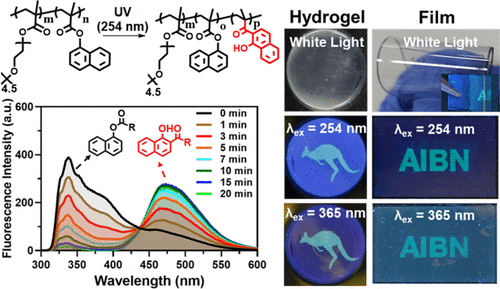当前位置:
X-MOL 学术
›
Macromolecules
›
论文详情
Our official English website, www.x-mol.net, welcomes your
feedback! (Note: you will need to create a separate account there.)
Photo/Thermal Dual Responses in Aqueous-Soluble Copolymers Containing 1-Naphthyl Methacrylate
Macromolecules ( IF 5.1 ) Pub Date : 2021-05-07 , DOI: 10.1021/acs.macromol.1c00297 Jiacheng Zhao 1, 2 , Gerald Tze Kwang Er 1, 2 , Francis J. McCallum 1, 2 , Sisi Wang 1, 2 , Changkui Fu 1, 2 , Joshua A. Kaitz 3 , James F. Cameron 3 , Peter Trefonas 3 , Idriss Blakey 1 , Hui Peng 1, 2 , Andrew K. Whittaker 1, 2
Macromolecules ( IF 5.1 ) Pub Date : 2021-05-07 , DOI: 10.1021/acs.macromol.1c00297 Jiacheng Zhao 1, 2 , Gerald Tze Kwang Er 1, 2 , Francis J. McCallum 1, 2 , Sisi Wang 1, 2 , Changkui Fu 1, 2 , Joshua A. Kaitz 3 , James F. Cameron 3 , Peter Trefonas 3 , Idriss Blakey 1 , Hui Peng 1, 2 , Andrew K. Whittaker 1, 2
Affiliation

|
Photoresponsive polymers capable of luminescence switching are attracting significant interest due to their potential application in fluorescence patterning, bioimaging, optical data storage, and anti-counterfeiting. In this work, we have developed aqueous-soluble copolymers of 1-naphthyl methacrylate and oligo(ethylene glycol) methyl ether methacrylate [P(1-NMA-co-OEGMA)] that undergo a significant shift in fluorescence emission wavelength after UV irradiation. Irradiation of the 1-naphthyl methacrylate moieties results in the photo-Fries rearrangement to form hydroxy aryl ketones, which exhibit strong emission at 475 nm through excited-state intramolecular proton transfer (ESIPT) and excited-state proton transfer (ESPT). The resultant shift in fluorescence emission maximum from 338 to 475 nm after rearrangement can potentially be exploited for fluorescence patterning. Furthermore, the copolymers are thermally sensitive in aqueous solutions. The lower critical solution temperature (LCST) of the copolymers depends on the content of hydrophobic 1-naphthyl methacrylate units; the photo-Fries rearrangement results in a more polar structure, shifting the LCST to a higher temperature. Of note, the temperature-triggered volume phase transition of copolymer hydrogels selectively ″switches off″ fluorescence arising from the ESPT mechanism, while the ESIPT emission is unaffected. We also demonstrate that films formed by coating the copolymers onto various substrates can be selectively patterned to form gradients in fluorescence intensity. These versatile P(1-NMA-co-OEGMA) copolymers are simple to prepare at low cost, demonstrate effective photoswitching, and have excellent water solubility, thus ensuring potential applications in a number of important areas.
中文翻译:

含甲基丙烯酸1-萘酯的水溶性共聚物的光/热双重响应
能够发光转换的光敏聚合物由于其在荧光图案,生物成像,光学数据存储和防伪中的潜在应用而引起了人们的极大兴趣。在这项工作中,我们开发了甲基丙烯酸1-萘酯和低聚乙二醇乙二醇甲基丙烯酸甲酯[P(1-NMA- co-OEGMA)],在紫外线照射后荧光发射波长发生明显变化。辐照甲基丙烯酸1-萘酯基团导致光-弗里斯重排以形成羟基芳基酮,该羟基芳基酮通过激发态分子内质子转移(ESIPT)和激发态质子转移(ESPT)在475 nm处显示出强发射。重排后所得的最大荧光发射位移从338 nm移至475 nm,可以潜在地用于荧光图案化。此外,共聚物在水溶液中对热敏感。共聚物的较低临界溶液温度(LCST)取决于疏水性甲基丙烯酸1-萘酯单元的含量。炸薯条的重排导致极性更强的结构,从而将LCST移至更高的温度。值得注意的是 共聚物水凝胶的温度触发的体积相变会选择性地“关闭”由ESPT机制产生的荧光,而ESIPT发射不会受到影响。我们还证明了通过将共聚物涂覆到各种基材上而形成的膜可以选择性地图案化以形成荧光强度的梯度。这些通用的P(1-NMA-共-OEGMA)共聚物易于低成本制备,显示出有效的光开关性并具有出色的水溶性,因此可确保在许多重要领域中的潜在应用。
更新日期:2021-05-25
中文翻译:

含甲基丙烯酸1-萘酯的水溶性共聚物的光/热双重响应
能够发光转换的光敏聚合物由于其在荧光图案,生物成像,光学数据存储和防伪中的潜在应用而引起了人们的极大兴趣。在这项工作中,我们开发了甲基丙烯酸1-萘酯和低聚乙二醇乙二醇甲基丙烯酸甲酯[P(1-NMA- co-OEGMA)],在紫外线照射后荧光发射波长发生明显变化。辐照甲基丙烯酸1-萘酯基团导致光-弗里斯重排以形成羟基芳基酮,该羟基芳基酮通过激发态分子内质子转移(ESIPT)和激发态质子转移(ESPT)在475 nm处显示出强发射。重排后所得的最大荧光发射位移从338 nm移至475 nm,可以潜在地用于荧光图案化。此外,共聚物在水溶液中对热敏感。共聚物的较低临界溶液温度(LCST)取决于疏水性甲基丙烯酸1-萘酯单元的含量。炸薯条的重排导致极性更强的结构,从而将LCST移至更高的温度。值得注意的是 共聚物水凝胶的温度触发的体积相变会选择性地“关闭”由ESPT机制产生的荧光,而ESIPT发射不会受到影响。我们还证明了通过将共聚物涂覆到各种基材上而形成的膜可以选择性地图案化以形成荧光强度的梯度。这些通用的P(1-NMA-共-OEGMA)共聚物易于低成本制备,显示出有效的光开关性并具有出色的水溶性,因此可确保在许多重要领域中的潜在应用。


















































 京公网安备 11010802027423号
京公网安备 11010802027423号